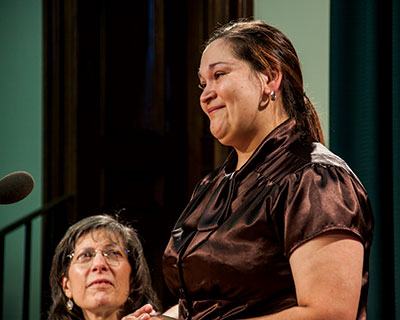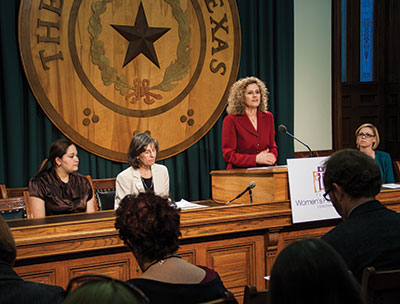Damage control: Mending Texas’ women’s health care safety net

By Kate Alfano
Severe budget cuts from the 82nd Texas Legislature left the women’s health care safety net in tatters, but supported by a strong fiscal and public health policy argument, a bipartisan coalition is working to restore funding for wellness, preventive, and family planning services.
Beneath a grand, wooden replica of the Texas state seal, Anavi Cantu timidly looked out at the large group of news reporters, legislators, and legislative staffers gathered in a Capitol press room and, with a little encouragement from her family physician sitting beside her, spoke a simple message: the family planning and preventive services provided by the state are “really important” to women like her.

An emotional Cantu addresses press conference attendees
She and her husband each have two jobs, Cantu explained, and she’s a full-time student; they have two kids. “Without the clinic, without any funding, it would be really hard for people like me and my husband in Robstown,” she said, her voice wavering. “We’re just trying to make it even if we have to have two jobs. We couldn’t afford to have another child. Without [these services], I don’t know where we’d be.”
Her family physician, TAFP member Janet Realini, M.D., M.P.H., is a leading advocate for women’s health care in Texas and chair of a new coalition created in the wake of severe cuts to the women’s health care safety net following the 82nd Texas Legislature in 2011. The Texas Women’s Healthcare Coalition—comprised of a growing group of public policy, faith-based, and health care organizations, including TAFP—held the press conference in mid-February to present their platform and build support for their cause.
“This is what it’s about,” Realini said after Anavi sat down. “It’s about real people who need services so their families can be healthy, so they can be healthy to take care of their children, to make their way in life, to improve their life.”
Texas has two programs that provide low-income women access to basic preventive, wellness, and preconception health care like well-woman examinations, diabetes screening, breast and cervical cancer screening, contraceptive counseling, and a variety of FDA-approved birth control methods: the Department of State Health Services Family Planning Program and the Texas Women’s Health Program. Once pregnant, low-income women are eligible for Medicaid but non-pregnant women are generally not eligible.
The DSHS Family Planning Program is supported mostly by federal dollars from Title X (Family Planning), Title XX (Social Services Block Grant), and Title V (Maternal and Child Health Block Grant), according to TWHC. In the 2010-2011 biennium, 80 percent of its funding came from the federal government. The Women’s Health Program, authorized by the Texas Legislature in 2005 and implemented in 2007 as a five-year Medicaid waiver demonstration project, received 90 percent of its funding from the federal government. From its inception, the legislation authorizing WHP contained explicit language prohibiting qualifying clinics from performing elective abortions, relevant to note for the budget battle of the 82nd Legislature.
In May 2011, capping a contentious budget session that pitted each high priority against another, family planning advocates watched in dismay as lawmakers openly attacked this funding—politicized by the abortion debate and, some say, fueled by an ongoing feud between conservative lawmakers and Planned Parenthood—and amended the budget from the floor to appropriate these dollars elsewhere. By the time the dust had settled, lawmakers approved a state budget that cut funding for the DSHS Family Planning Program by 66 percent, from $55.6 million to $19 million.
Additionally, a tier system was enacted to prioritize funding for public clinics and hospitals over family planning clinics. And while lawmakers authorized renewal of the federal waiver supporting WHP, a rule created earlier in the session by the Texas Health and Human Services Commission excluded Planned Parenthood—which formerly provided more than 40 percent of preventive health and family planning services—from participating as a provider in the program.
TWHC estimates that more than 1 million Texas women ages 20-44 need publicly supported health care and contraception, and even when Texas’ two family planning programs were fully functioning, they could only provide services to about one-third of the women who needed care, or roughly 340,000.
“The safety net for women’s health care is in tatters. We need to put funding back, put the resources back, rebuild our safety net as quickly as possible so that Anavi and her family, and so many other women, men, and families around the state have access to preventive care so their families can improve their lives.”
–Janet Realini, M.D., M.P.H.
Chair, Texas Women’s Healthcare Coalition
Because of the cuts and the funding tiers enacted by the 82nd Legislature, the number of women the DSHS program will serve is expected to drop to 65,000 per year in 2014 and 2015, down from the 212,000 served in fiscal year 2010. Also, 167 clinics across the state lost funding and at least 53 have closed, two-thirds of which were run by entities unrelated to Planned Parenthood. Many more have reduced hours or the number of family planning appointments they can provide.
Public health consequences aside, the fiscal consequences to the state are receiving renewed attention. “We’ve had estimates from DSHS and HHSC that we could anticipate having 24,000 additional unplanned pregnancies in the upcoming biennium, and that will actually cost Texas taxpayers $103 million in Medicaid care for these births that were not planned rather than paying much less up front for the preventive services,” State Rep. Donna Howard, D-Austin, said at the press conference.
“On top of this, there have actually been increased costs in the current fiscal year of approximately $33 million for the additional births caused as a result of those cuts. I think it’s very clear that this is a program that makes a huge difference in cost containment. And as I’ve said multiple times, it makes good public policy and good fiscal policy to refund and restore this program for the women in Texas.”

Rep. Howard speaks to members of the press
State Rep. Sarah Davis, R-West University Place, a breast cancer survivor who supports routine screening, spoke at the press conference of her concern for the Women’s Health Program. As a result of the provider exclusion, the federal Centers for Medicare and Medicaid Services declined to renew Texas’ WHP waiver. Texas Gov. Rick Perry has pledged that WHP will continue, but as a state-run program without federal support and not a federal-state partnership. To maintain WHP at its current level, Texas must replace more than $30 million annually in lost federal funding, TWHC estimates.
Davis said at the press conference that legislators have found the funding for the program, but the most significant challenge will be ensuring the delivery system has the providers to care for the patients the program serves. The state will be on the hook for additional Medicaid costs for maternity and infant care if provider capacity is not sufficient to maintain the number of women served.
“We’re in this era where we want to minimize the cost to the state, we want to minimize the taxpayer dollars that we spend, and really it’s fortunate that we have women’s preventive health care because it’s one of the most cost-effective ways to help lessen the cost to Medicaid,” Realini said. For every dollar the state spends on family planning care, including contraceptive care and preventive screenings, we save at least $3.74 by helping women avoid unplanned pregnancy, and avoiding the Medicaid costs for pregnancy, birth, and infant health care, she explained. “More recent estimates have it even higher, so that’s a conservative estimate.”
TWHC is asking lawmakers to restore DSHS family planning funding to 2010-2011 levels, back to $55.6 million per year to restore access for the 147,000 women cut from the program; fully fund the Texas Women’s Health Program at a cost of $36 million per year to maintain services for 130,000 women; and ensure ample provider capacity for the Women’s Health Program with active monitoring and aggressive action to expand provider capacity.
“The safety net for women’s health care is in tatters,” Realini said. “We need to put funding back, put the resources back, rebuild our safety net as quickly as possible so that Anavi and her family and so many other women, men, and families around the state have access to preventive care so their families can improve their lives.”
Both Davis and Howard expressed optimism that their colleagues in the House will address these funding concerns. “I am encouraged from the response we’re getting that even those who had an ideological reason for wanting the cuts recognize that this went beyond what some of them had anticipated,” Howard said. “They recognize that we have to restore these funds and get these services back in place.”
“I am encouraged from the response we’re getting that even those who had an ideological reason for wanting the cuts recognize that this went beyond what some of them had anticipated. They recognize that we have to restore these funds and get these services back in place.”
–Rep. Donna Howard
And there’s similar sentiment on the Senate side. State Sen. Jane Nelson, R-Flower Mound, who chairs the Senate Finance Committee’s Article II Workgroup, announced her support for adding $100 million to the base budget for women’s health services.
“It’s time for us to unite behind solutions we can all agree are in the best interest of keeping Texas women healthy,” she said in a February press release. “I believe in the power of prevention, and our plan will ensure that Texas women have access to the best possible preventive services, such as cancer screenings. In addition to making this investment, it is important that we grow our network of providers, expand access for women in rural communities, and recognize that family planning is a critical component of our efforts to support the health of Texas women.”
But, restoring funding is just the first step, Howard said. “Even with restoring the funds, I think we’re going to be struggling to get these programs up and running. Over 53 clinics were closed; they don’t exist anymore. We have to create more. And then of course if Planned Parenthood is not a part of this and they were providing a number of services here, that exacerbates the issue. We have challenges ahead, even with the funding, but we must restore the funding.”
